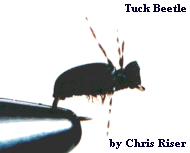Tuck Beetle

Chris Riser, riser@email.unc.edu
PATTERN:
Hook: Standard Dry Fly
Thread: Black #6/0
Body: Peacock Herl
Shellback: Black Closed-Cell Foam
Legs: Black Kyrstal Flash
Tying Instructions:
1. Tie in thread just behind hook eye. Wrap back to bend. Tie in 3-4 strands
and a piece of black #3/0 thread. Wrap tying thread back up to behind the
eye. Twist the herl and thread together to make a rope. Wrap herl rope
forward to about 1 1/2 eye widths behind the eye. Secure with thread and wrap
thread back over body to bend. Wrap herl rope back to bend and secure with
thread. Clip excess herl.
2.Tie in a narrow strip (about 1/8" wide and 5/16" long for a #16) of black
foam. Tie in the strip on one end with the long end pointing back at the
vise. Secure well with thread and wrap the thread back over the herl body up
to the wrap off point behind the eye. Pull the foam forward and secure at the
wrap off point with several wraps of thread. Don't wrap so tightly that you
cut through the foam. Leave thread hanging and prepare the legs.
3. Cut a single strand of Krystal Flash in half. Take one half and fold it in
half and in half again. Place the center of this folded bunch on the thread
collar you have created at the foam tie-down point. Tie in the Krystal Flash
with figure-eight wraps. Whip finish. Cut the Krystal Flash to length of
about one body length and you will have created four legs on each side-you
can cut two off to get the standard six if you like.
4. Pull somewhat tightly (not too much or the foam may tear) on the remaining
piece of foam sticking up from under the thread collar and pull it up and
toward the hook eye. Using a single-edged razor blade, carefully slice down
and cut off the excess foam in front of the collar to form a head. Varnish
the collar wraps.
Notes:
Try this fly when there's no hatch on. It's worked especially well for me in
the summer. It rides on top for a while, then in the film, and sometimes
sinks to a foot or so, but that's OK, because that's what real beetles do. I
usually use it as a searching pattern and cast it upstream and across, so I
can keep its drift as drag-free as possible while maintaining as tight a line
as possible to detect strikes once it drops below the film.
BACK TO TFS

